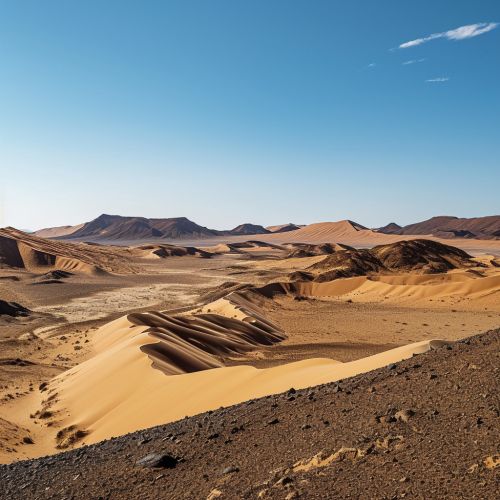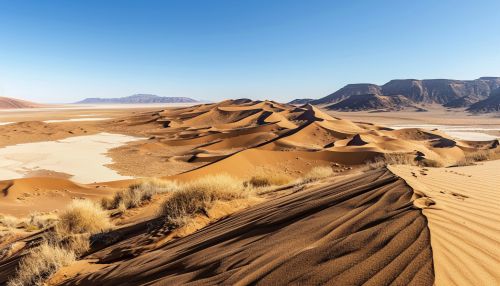Namib Desert
Geography
The Namib Desert is a coastal desert primarily located in Namibia, with portions extending into Angola and South Africa. It is considered one of the oldest deserts in the world, with an estimated age of 55 to 80 million years. The desert spans an area of approximately 81,000 square kilometers, extending along the Atlantic coast for about 2,000 kilometers from the Angolan border in the north to the Orange River in the south. The desert's width varies from 50 to 160 kilometers.


Climate
The climate of the Namib Desert is characterized by extreme aridity, with annual rainfall ranging from 2 millimeters in the most arid regions to 200 millimeters in the less arid areas. Despite the low rainfall, the desert experiences high humidity due to the cold Benguela Current that flows northward along the Atlantic coast, causing frequent fog and dew. This fog is a crucial source of moisture for the desert's flora and fauna, enabling a variety of species to survive in this harsh environment.
Geology
The geology of the Namib Desert is diverse and complex. The desert is primarily composed of two types of sand dunes, namely star dunes and barchan dunes. The star dunes are found in the northern part of the desert, while the barchan dunes dominate the southern part. These dunes are composed of grains of quartz and feldspar, which have been eroded from the Kalahari Desert and transported by the Orange River. The desert also features inselbergs, or isolated mountains, which are remnants of ancient landscapes that have been eroded over millions of years.
Flora and Fauna
Despite its harsh conditions, the Namib Desert supports a diverse range of flora and fauna. The desert is home to a variety of plant species, including the endemic Welwitschia mirabilis, a plant known for its longevity and resilience. The desert also hosts a variety of animal species, including several types of insects, reptiles, and mammals. Some notable species include the Namib Desert beetle, which has adapted to collect water from fog, and the desert elephant, which has adapted to survive in the arid environment.
Human History
The Namib Desert has been inhabited by humans for at least 6,000 years. The earliest inhabitants were the San people, also known as the Bushmen, who were hunter-gatherers. They were later joined by the Damara people, who introduced pastoralism to the region. In the 19th century, the desert was colonized by the Germans, who established the colony of German South West Africa. Today, the desert is sparsely populated, with most inhabitants living in small towns and villages along the coast.
Conservation and Tourism
The Namib Desert is a major focus of conservation efforts in Namibia. The Namib-Naukluft National Park, which covers a large portion of the desert, is one of the largest conservation areas in Africa. The park is home to a variety of unique species and is a popular destination for tourists. Tourism in the desert is primarily focused on eco-tourism, with visitors drawn to the desert's unique landscapes and biodiversity.
